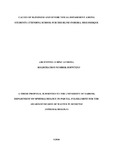| dc.contributor.author | Almeida, Argentino A | |
| dc.date.accessioned | 2016-11-15T09:22:35Z | |
| dc.date.available | 2016-11-15T09:22:35Z | |
| dc.date.issued | 2016 | |
| dc.identifier.uri | http://hdl.handle.net/11295/97269 | |
| dc.description.abstract | Background/Introduction: The World Health Organization defines low vision as visual acuity of less than 6/18, but equal to or better than 3/60), or visual field loss to less than 20 degrees, in the better eye with best possible correction. Blindness is defined as visual acuity of less than 20/400 (3/60), or a visual field loss to less than 10 degrees, in the better eye with best possible correction.
Objectives: The overall objective of this study is to determine the causes of severe visual impairment (SVI) and Blindness (BL) among students attending schools for the blind in Beira, Mozambique. The specific objectives were to: (i) determine the anatomical and etiological causes of BL/SVI, and (ii) determine possible avoidable causes of BL/SVI.
Study design: Descriptive cross-sectional study.
Method: Ninety-nine students attending the schools for the blind in Beira Mozambique were interviewed and examined using the Modified WHO/PBL Eye Examination Record for Children with Blindness and Low Vision Form.
Results: The study established that a majority of the anatomical factors related to BL/SVI, whole globe pathology accounting for 39.6% of the cases, while those affecting the cornea were 34.1%, optic nerve 12.3%,lens 6.%, uvea 2.2%, and retina 1.1%. This finding leads to an understanding that the most common cause of BL/SVI are those that affect the whole globe and the cornea. By etiological classification, 33% of the etiological factors causing BL/SVI were postnatal factors, 10.9 % were perinatal, 10 % were intrauterine and in 46.1% the etiology was nonspecific. And 71.4% of the causes of BL/SVI were potentially avoidable.
Conclusions: A high proportion of childhood blindness in schools for the blind in Beira Mozambique is avoidable. The major anatomical site of BL/SVI were phthisis and cornea scar. The childhood factors (measles, harmful traditional practices and vitamin-A deficiency) were the main underling etiology causes.
The study emphasizes the importance of awareness increasing among the public and specialist pediatric ophthalmologist in the management of childhood eye diseases in Mozambique. | en_US |
| dc.language.iso | en | en_US |
| dc.publisher | University of Nairobi | en_US |
| dc.rights | Attribution-NonCommercial-NoDerivs 3.0 United States | * |
| dc.rights.uri | http://creativecommons.org/licenses/by-nc-nd/3.0/us/ | * |
| dc.subject | Blindness and Severe Visual Impairment | en_US |
| dc.title | Causes of Blindness and Severe Visual Impairment Among Students Attending School for the Blind in Beira, Mozambique | en_US |
| dc.type | Thesis | en_US |
| dc.description.department | a
Department of Psychiatry, University of Nairobi, ; bDepartment of Mental Health, School of Medicine,
Moi University, Eldoret, Kenya | |



